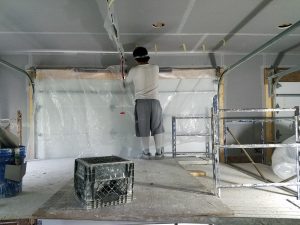 Plaster is a consistently used material in building construction. It’s a crucial component when mounting blueboard and it’s been used since ancient times. Formerly mud was used to plaster reed or sapling huts to act as a screen against the elements. As civilization has advanced, we’ve developed a specific compound to use in building for coating on walls, ceilings, and partitions.
Plaster is a consistently used material in building construction. It’s a crucial component when mounting blueboard and it’s been used since ancient times. Formerly mud was used to plaster reed or sapling huts to act as a screen against the elements. As civilization has advanced, we’ve developed a specific compound to use in building for coating on walls, ceilings, and partitions.
So why does the composition of plaster matter? Plaster has a rich history of Greek architecture, ornamental plaster ceilings in England, Roman buildings, and more. It’s a versatile compound that can be used to decorate and design walls, ceilings, and more. The composition of plaster is important because of the components used within form a protective coating on whatever they are applied to. They ensure that the underlying walls, ceiling, or surface are protected from damage and scratches.
The Composition
Plaster is comprised of a few common materials, namely gypsum, lime, or cement.
- Gypsum is “a soft sulfate mineral composed of calcium sulfate dihydrate.” It’s the main component of many forms of plaster, blackboard and sidewalk chalk, and drywall.
- Lime plaster “is a type of plaster composed of sand, water, and lime, usually non-hydraulic hydrated lime.”
- Cement plaster “is a mixture of suitable plaster, sand, portland cement, and water.”
Each material has benefits and drawbacks based on the composition and location where it is used. The usage of the plaster is also important, as reliefs will require different compositions than a wall layer. Your contractor will advise you on the best plaster to choose for a project, so you don’t need to worry about researching and choosing the best plaster for your particular project.
Benefits and Drawbacks
Gypsum is a common material in drywall, so it’s frequently found on job sites. Gypsum is a mined mineral that is commonly used in sculptures and other installations. It’s better known as Plaster of Paris. Gypsum plaster can be applied on brick, solid or hollow blocks, as well as plasterboards and other materials. It has strong insulation properties and is moderately fire and impact resistant.
Lime is a commonly used exterior plaster. It has been found in ancient Roman and Greek structures, so it’s a common building material. It is a non-hydraulic plaster, so it sets slowly and is very caustic when wet. Lime plaster is typically not used indoors but remains an exterior building material.
Cement plaster is another common wall coating material. It is applied to masonry interiors and exteriors for a smooth surface. Cement-based plaster is sometimes used for exterior fireproofing, protecting pipe bridges, and more. When cement plaster is used inside it is often covered with another layer of gypsum plaster for a final smooth layer.
Residential and Commercial Uses
Twin City Blueboard works primarily with gypsum plaster. Since gypsum plaster is a commonly used material for blueboard finishing and interior decoration, it’s a great choice for custom wall designs and as a sealing coat. Some plaster can be formed into complex detailing for room interiors, and are secured with the help of fasteners.
We use plaster to provide a smooth coat for painting in our projects. If customers desire a custom design or detail work, we will work it into the plaster coats. Twin City Blueboard is your best choice for interior plastering, so don’t hesitate to contact our team!
